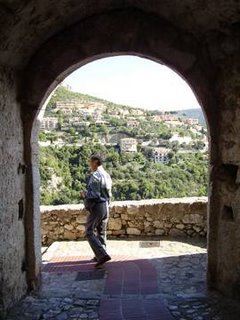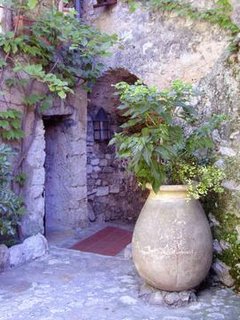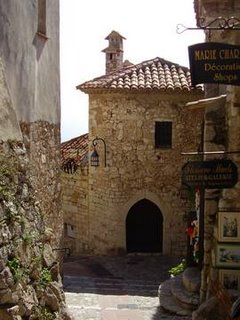I visited Eze for the 4th time, I think, at the end of October when my parents were visiting us.
Eze is one of the prettiest mediaeval villages near here; absolutely pristine and immaculately kept - a huge contrast from the run down and damp old town of Vintimille that's just across the border in Italy.
It does get busy with tourists in the summer but it still has a nice atmosphere. The breathtaking views and sun dappled honey coloured stone buildings make the visit worthwhile-although very hard going as the streets are cobbles and the paths are very steep.
This is the fortified gate and entrance to the village built in the 14th century. Originally, a drawbridge and ditch were part of the defences.

This is the view from the entrance to the village.

And the same view through the gateway. The remains of hinges and places to insert heavy wooden bolts are still visible.

An archway with a sign leading to the famous 4 star hotel/Michelin starred restaurant Château de la Chèvre d’Or, not in my budget though.
The Chèvre d’Or name either comes from a local fairytale or from a previous owner's miserly habit of hiding gold coins [the profits from selling goat's milk] in the walls of the building which were found during early renovation work -or so the story goes.

On a sunny day, the village is is a blend of sun and shade due to the narrow paths and alley ways.
 A typical shady and tiny courtyard showing some very small doorways - the majority of people would need to stoop down when entering here.
A typical shady and tiny courtyard showing some very small doorways - the majority of people would need to stoop down when entering here. Narrow lanes and higgledy piggledy houses and shops.
Narrow lanes and higgledy piggledy houses and shops.Lots of houses are also artist or craft workshops selling paintings , leather , glass and ceramic work.

Due to the village fortification andwalls, most of the paths circle round and many of the building have strangely shaped outer walls to fit into the restricted space.
 The village is an entirely pedestrian area and no motiorised vehicles are allwoed- even for deliveries of goods. Moving house or delivering requires teams of strong people with hand carts, though donkeys were used in the past.
The village is an entirely pedestrian area and no motiorised vehicles are allwoed- even for deliveries of goods. Moving house or delivering requires teams of strong people with hand carts, though donkeys were used in the past. More arches, a small window and iron lamp and a saint's statue build into the wall for protection.
More arches, a small window and iron lamp and a saint's statue build into the wall for protection. A lot of the buildings in Eze have very decorative old ironwork - I would have liked to have taken more photos of these interesting features but i didn't think about it till after we were home.
A lot of the buildings in Eze have very decorative old ironwork - I would have liked to have taken more photos of these interesting features but i didn't think about it till after we were home. The Baroque Eglise Notre Dame de l'Assomption [Church of Our Lady of the Assumption] was dedicated in 1772 and designed by the architect Antonio Spinelli.
The Baroque Eglise Notre Dame de l'Assomption [Church of Our Lady of the Assumption] was dedicated in 1772 and designed by the architect Antonio Spinelli.The locals say that the thousands of stones needed for the church were carried from the quarry up the steep hillside, on the backs of local men completely free of charge.
The inside of the church is highly decorated and ornate but no photos are allowed as it is a place of worship.
 I took the photo a few years ago on a previous visit -there is a small ancient stable at the foot of the village where donkeys used to be kept to carry baggage and goods into the village. The donkeys belong to teh village and are apparently only kept in the stable on Sundays and spend the rest of their time grazing in nearby fields.
I took the photo a few years ago on a previous visit -there is a small ancient stable at the foot of the village where donkeys used to be kept to carry baggage and goods into the village. The donkeys belong to teh village and are apparently only kept in the stable on Sundays and spend the rest of their time grazing in nearby fields.
Technorati Tags:
photos
Eze
riviera
France
mediaeval
village
donkey
arch




2 comments:
Looks like a stunning place, Alison. I'm reminded, a bit, of San Gimignano in Tuscany. Lovely photos - as always.
now I know what to expect if I ever make it there - lol. Great photos, looks like an interesting place, somehow seems difficult to imagine that people actually live there!
Post a Comment